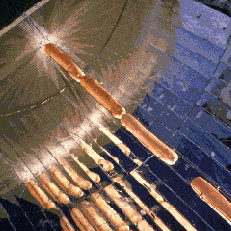Exhibition Activities |
 |
The following are description for the activities designed for the SEED workshops and exhibitions. All the activities are developed around the "alternative energy" theme
- Sun Seeker
- House Cooling Systems
- Solar Hot Dog Cooker
- Pot-in-Pot Cooling System
- Wave and Tidal Energy (Description with no suggested activities)
Sun Seeker
[ Full description ]
House Cooling Systems
Cooling of houses is an important topic for countries like Malaysia where temperatures are high year-round. Instead of using the power-hungry air-conditioning system, there are many other environmentally friendly techniques that can help cool a house. Many of these techniques can be applied to the structure of the house. This activity will encourage students to experiment with some. [ Full description ]
Hot Dog Cooker
This experiment aims to create a fun activity for students to realize the potential uses of solar energy. In addition to generating electricity, many examples exist of how heat from the sun can be utilized. Some examples include solar cookers, rooftop hot water systems, solar food dehydrators. Students will get a chance to try building a general purpose solar cooker. Different shapes and forms can be tried. A hot dog will be used as a test for their construction. [ Full description ]
Pot-in-Pot Cooling System
Mohammed Bah Abba, a Nigerian native, has won the 2001 Rolex Awards for Enterprise for his invention of a simple cooling system that can help preserve food in rural areas where there is no electricity. Eggplants stay fresh for 27 days, instead of the usual three. Tomatoes and peppers last for up to three weeks. The pot-in-pot system works simply by putting a smaller clay pot inside a larger one. The two are separated by a constantly moist sand. Evaporation causes a cooling affect in the inner pot. This activity will allow students to construct this cooling system. Some simple experiments will then be conducted to evaluate its functionality. [ Full description ]
Wave and Tidal Energy
Wave and tidal energy harvesting has been around for a few decades. But it has only been in recent years that it has started to become more realistic due to advance in research and technology. Some speculates that wave and tidal energy can supply at least 10 percent of the world's energy consumption. [ Full description ]




